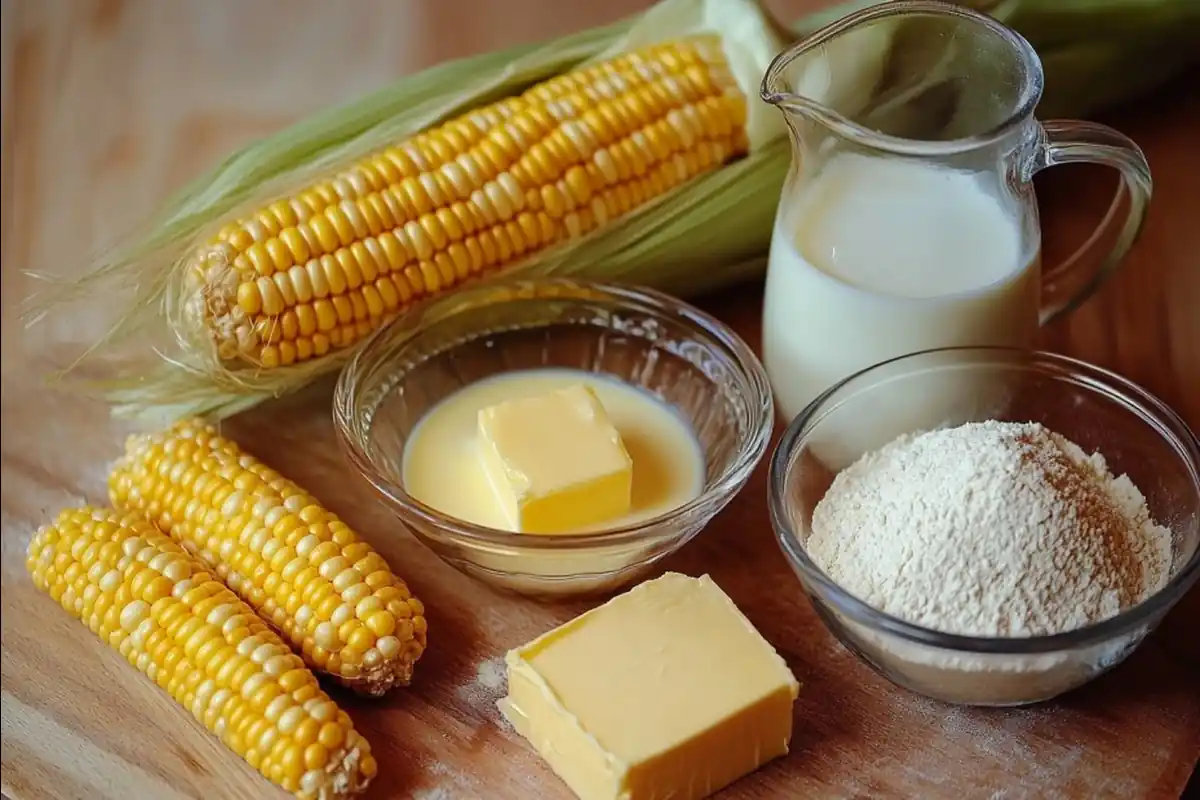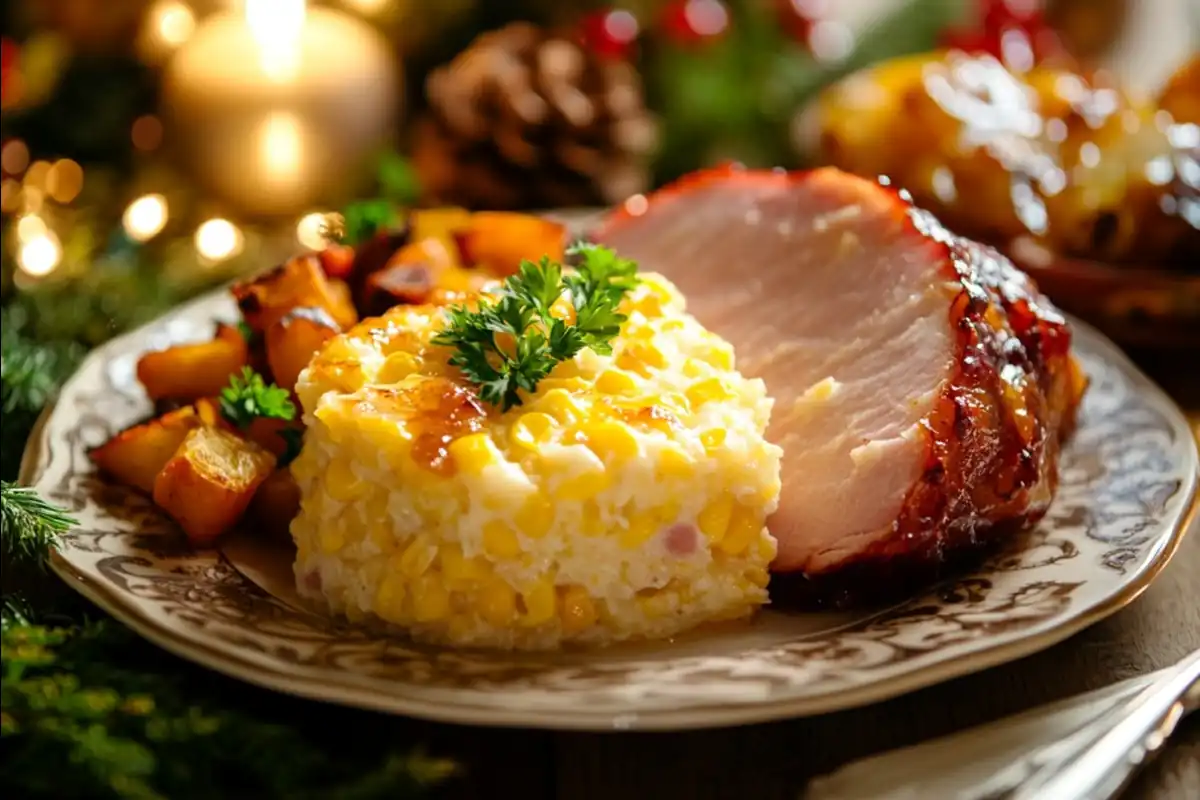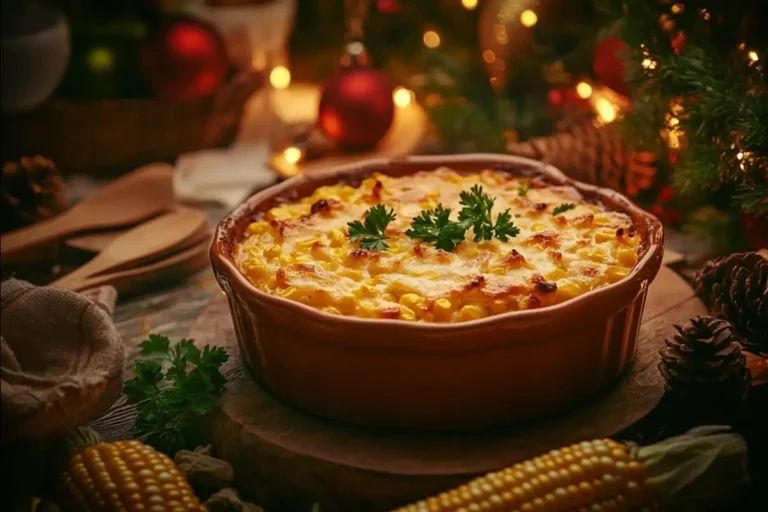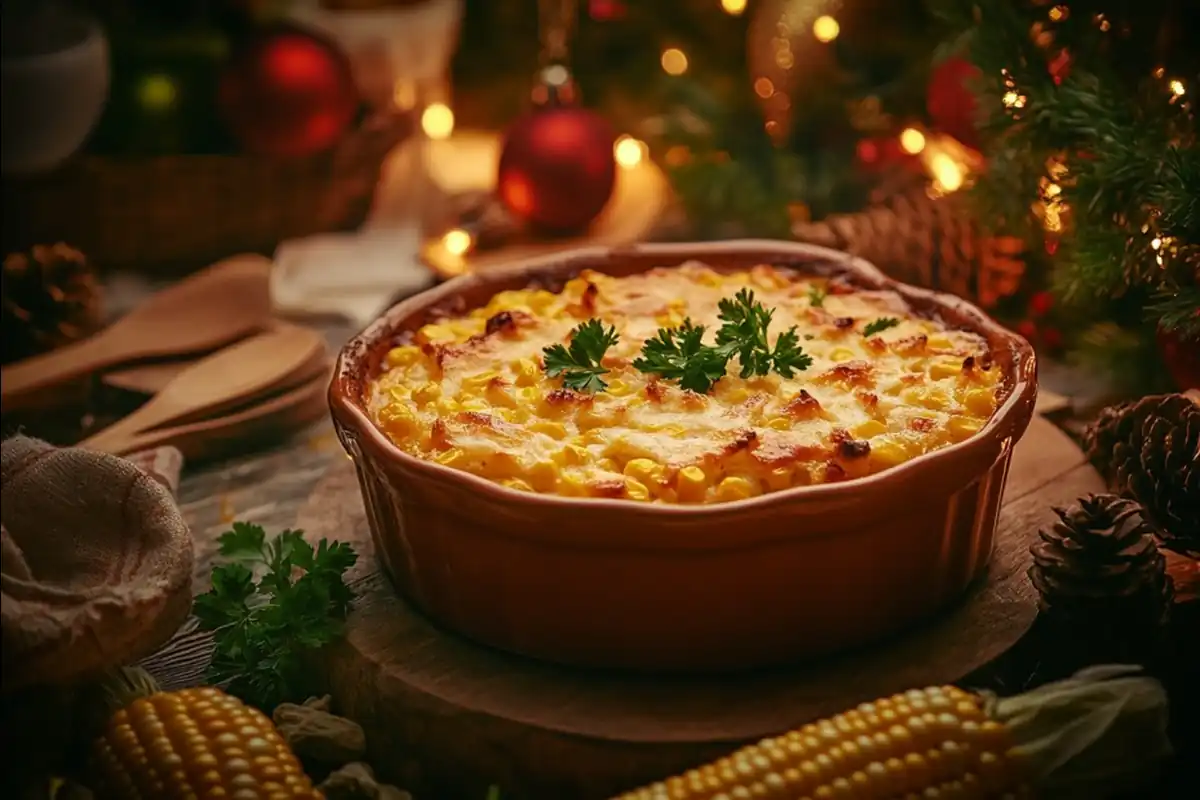1. Introduction
1.1 What Is Corn Pudding Made Of?
Corn pudding is a delightful dish that holds a special place in American cuisine, particularly in the South. Its creamy, custard-like consistency and sweet-yet-savory flavor therefore make it a must-have side dish for Thanksgiving, Christmas, and other holiday feasts.
At its core, the dish is made of simple, wholesome ingredients: corn (fresh, canned, or creamed), milk or cream, eggs, butter, and sugar. Moreover, these ingredients come together to create a rich, comforting dish that’s as versatile as it is satisfying. In addition, its popularity stems from its simplicity and the nostalgia it evokes at family dinners and festive gatherings.
In this article, we’ll explore not just what corn pudding is made of but also its variations, preparation techniques, and history. Whether you’re new to this dish or seeking fresh ideas to spice up a classic recipe, you’ll find everything you need here.
2. What Is Corn Pudding Made Of?
2.1 Core Ingredients in Corn Pudding Recipes
The true beauty of corn pudding, however, lies in its simplicity. Additionally, each ingredient plays a critical role in achieving its custard-like texture and balanced flavor. Therefore, here’s a breakdown of the essential components:
- Corn:
- Sweet corn kernels are undeniably the foundation of this dish. Additionally, you can use fresh, frozen, or canned corn, depending on availability. For instance, some recipes incorporate creamed corn, which not only adds extra moisture but also enhances sweetness for a smoother texture.
- Eggs:
- Eggs act as a binding agent, giving the pudding its signature custard consistency. They help create the creamy structure that holds the dish together.
- Milk or Cream:
- These provide richness and a silky texture. Whole milk or heavy cream is often used, but substitutions like almond or oat milk can work for dietary restrictions.
- Butter:
- Butter adds depth of flavor and a subtle creaminess that elevates the dish. Melted butter is often mixed into the batter for an even distribution.
- Sugar:
- Though optional, a small amount of sugar enhances the natural sweetness of the corn. For a savory variation, some recipes skip the sugar and include spices or herbs instead.
- Flour or Cornstarch:
- These thickeners help create a pudding-like consistency, ensuring the dish is neither too runny nor too dense.
2.2 Traditional Corn Pudding vs. Modern Recipes
While traditional corn pudding sticks to the core ingredients, modern recipes have evolved to include creative twists. Here’s a comparison:
- Traditional Corn Pudding:
- Focuses on simplicity, using basic ingredients like corn, eggs, milk, and butter.
- Often seasoned with just salt and pepper, allowing the natural sweetness of the corn to shine.
- Modern Variations:
- May incorporate additional flavors like shredded cheese, diced jalapeños, or crumbled bacon.
- Adjustments for dietary needs include using plant-based ingredients for vegan or gluten-free versions.
2.3 Why Each Ingredient Is Essential in Corn Pudding
Every ingredient in corn pudding serves a specific purpose:
- Corn: Adds texture and sweetness, serving as the base of the dish.
- Eggs: Provide structure and ensure the pudding holds its shape.
- Milk or Cream: Offers richness and a smooth texture.
- Butter: Balances flavors and enhances creaminess.
- Flour or Cornstarch: Prevents the dish from being watery, giving it the perfect consistency.
3. Variations of Corn Pudding
3.1 Global Influences: Unique Corn Pudding Recipes Around the World
Corn pudding is beloved across different cultures, and while the classic American recipe is well-known, global influences have given rise to unique variations. Here are some noteworthy examples:
- Mexican Elote-Inspired Corn Pudding:
This version takes inspiration from elote, or Mexican street corn. Specifically, ingredients like cotija cheese, lime juice, chili powder, and cilantro are added to the base recipe. As a result, the dish transforms into a tangy, spicy twist that ultimately adds bold and exciting flavors. - Caribbean-Style Corn Pudding:
Caribbean variations often include coconut milk, allspice, and a touch of nutmeg, giving the pudding a rich, tropical flavor. Some recipes also incorporate scotch bonnet peppers for a hint of heat. - Indian-Inspired Corn Pudding:
Indian spices like turmeric, garam masala, and cumin can transform corn pudding into an aromatic and colorful dish. Additionally, this variation often pairs well with savory meals, or alternatively, it can shine as a standalone dish.
3.2 Diet-Friendly Corn Pudding: Vegan, Gluten-Free, and Keto Options
Adapting corn pudding to fit dietary restrictions or preferences is easier than you might think. Here are some variations tailored to specific needs:
- Vegan Corn Pudding:
- Replace eggs with flaxseed or chia seeds.
- Use plant-based milk like almond or soy milk and vegan butter.
- Opt for cornstarch or arrowroot powder as a thickening agent.
- Keto Corn Pudding:
- Substitute traditional corn with riced cauliflower to reduce carbs.
- Use heavy cream for richness and almond flour as a thickener.
- Incorporate keto-friendly sweeteners like erythritol if desired.
- Gluten-Free Corn Pudding:
- Replace flour with cornstarch or gluten-free all-purpose flour.
- Ensure all other ingredients, such as baking powder, are certified gluten-free.
3.3 Creative Ways to Customize Corn Pudding Recipes
One of the best things about corn pudding is how versatile it is. Here are some creative ways to customize your dish:
- Add Cheese:
- Shredded cheddar, Monterey Jack, or Parmesan can add a savory, gooey element to the pudding.
- Include Heat:
- Diced jalapeños, red pepper flakes, or hot sauce can give your dish a spicy kick.
- Incorporate Protein:
- Mix in crumbled bacon, cooked sausage, or shredded chicken for a hearty variation.
- Make It Sweet:
- Add vanilla extract, cinnamon, or nutmeg for a dessert-like version.
4. Nutritional Insights
4.1 Calorie Count and Health Benefits of Corn Pudding
Corn pudding is a rich dish, but understanding its nutritional profile can help you make informed decisions when enjoying it. Here’s a breakdown of the average calorie content per serving (based on a traditional recipe):
- Calories: Approximately 200–250 calories per serving (1/2 cup).
- Fat: 10–15 grams, primarily from butter and milk or cream.
- Carbohydrates: 25–30 grams, with corn and sugar as the main contributors.
- Protein: 3–5 grams, primarily from eggs and milk.
The exact nutritional content will vary depending on the ingredients and portion sizes, but corn pudding can be enjoyed as part of a balanced diet.
4.2 Healthier Corn Pudding Substitutions for Every Diet
For those looking to reduce calories or make the dish healthier, here are a few adjustments:
- Lower Fat Options:
- Replace whole milk or cream with low-fat milk or unsweetened almond milk.
- Reduce the amount of butter or use a plant-based alternative.
- Cutting Sugar:
- Skip the sugar altogether for a more savory version. Alternatively, use natural sweeteners like honey or stevia.
- Increasing Fiber:
- To boost fiber content, you can also add a handful of finely chopped vegetables, such as bell peppers, spinach, or zucchini.
- Portion Control:
- Serve smaller portions as a side dish to keep calorie intake in check.
4.3 Why Corn is the Star Ingredient in Corn Pudding
Corn itself is a nutrient-rich ingredient that offers several health benefits:
- Rich in Fiber: Supports digestive health and helps maintain steady energy levels.
- Vitamins and Minerals: Provides vitamin C, magnesium, and potassium.
- Gluten-Free: Naturally suitable for those with gluten sensitivities or celiac disease.
While corn pudding is undoubtedly indulgent, these benefits make it a worthy addition to your holiday menu or occasional family dinner.
5. Preparation and Troubleshooting Tips
5.1 Step-by-Step Recipe for Perfect Corn Pudding
Making corn pudding at home is straightforward, but attention to detail ensures the perfect consistency and flavor. Follow these steps for a foolproof recipe:

- Step 1: Gather Ingredients
Prepare corn, eggs, milk or cream, butter, sugar, flour or cornstarch, and your preferred seasonings. - Step 2: Preheat the Oven
Set the oven to 350°F (175°C) and grease your baking dish to prevent sticking. - Step 3: Mix Wet Ingredients
In a large bowl, whisk together eggs, milk, melted butter, and sugar (if using). - Step 4: Add Dry Ingredients
Gradually mix in flour or cornstarch and stir until smooth. - Step 5: Incorporate Corn
Fold in corn kernels or creamed corn, ensuring an even distribution. - Step 6: Bake the Pudding
Pour the mixture into the greased baking dish and bake for 40–50 minutes, or until the center is set and slightly golden.
5.2 Solving Common Corn Pudding Cooking Problems
Even with the best recipe, occasional hiccups can occur. Here’s a table outlining common problems and their solutions:
| Problem | Cause | Solution |
|---|---|---|
| Pudding is too runny | Insufficient baking time | Bake longer; cover with foil if top browns too quickly. |
| Pudding is too dense | Too much flour or cornstarch | Reduce the amount of thickener in the recipe. |
| Lumpy texture | Improper mixing | Whisk wet and dry ingredients thoroughly before combining. |
| Overly sweet or bland flavor | Imbalanced sugar or seasoning | Adjust sugar and add salt or spices for balance. |
| Burnt edges with undercooked center | Uneven oven heat or incorrect dish size | Use a deeper dish and check oven calibration. |
5.3 Tips for Perfecting a Classic Corn Pudding Recipe
- Tip 1: Use Room-Temperature Ingredients
Let eggs and milk come to room temperature before mixing to ensure a smoother batter. - Tip 2: Rest Before Serving
Allow the pudding to cool slightly after baking. This helps it set and makes serving easier. - Tip 3: Customize with Toppings
Sprinkle shredded cheese, breadcrumbs, or fresh herbs on top before baking for added flavor and texture.
6. Serving and Pairing Suggestions

6.1 What to Serve with Corn Pudding: Perfect Pairings
Corn pudding is a versatile dish that complements a wide range of holiday meals. In fact, its creamy texture and balanced sweetness make it an ideal side for rich, savory main courses. Therefore, if you’re looking for the perfect accompaniment to your holiday spread, here are some excellent pairing suggestions:
- Turkey and Gravy:
A classic Thanksgiving pairing, corn pudding’s sweetness offsets the savory flavors of roasted turkey and rich gravy. - Glazed Ham:
The saltiness of a glazed ham contrasts beautifully with the custardy sweetness of corn pudding. - Roast Beef or Prime Rib:
Hearty beef dishes benefit from corn pudding’s creamy texture and mild flavor. - Vegetarian Meals:
Pair with roasted vegetables, a fresh green salad, or stuffed bell peppers for a vegetarian-friendly option.
6.2 Creative Ways to Plate and Present Corn Pudding
Presentation adds to the appeal of any dish. Here are some creative ways to serve corn pudding:
- Individual Servings:
Bake the pudding in ramekins for a refined, portioned presentation. - Layered Dishes:
Serve it as a base layer, topped with shredded pulled pork or sautéed vegetables. - Garnished with Herbs:
Sprinkle fresh parsley, chives, or cilantro on top for a pop of color and flavor.
6.3 Turning Corn Pudding into a Standalone Dish
It can also serve as an unexpected addition to casual meals:
- As a Breakfast Side: Pair with eggs and bacon for a comforting start to the day.
- As a Snack: Enjoy cold or reheated slices for a quick and satisfying snack.
- As a Dessert: For sweet versions, add whipped cream or a drizzle of honey to transform it into a
7. History and Cultural Significance
7.1 How Corn Pudding Became a Southern Comfort Food Staple
The dish has deep roots in American culinary traditions, particularly in Southern and Native American cuisines. Its origins date back to the early days of American colonization when settlers adapted Native American recipes using corn, a staple crop. Corn, also known as maize, was revered by Native Americans and used in a variety of dishes, from cornbread to hominy.
The introduction of European ingredients like milk, eggs, and butter transformed these traditional recipes into the creamy, custard-like dish we recognize today. Over time, corn pudding became a beloved comfort food, particularly in the South, where it was a staple at family gatherings and church potlucks.
7.2 Evolution of Corn Pudding in Modern American Cuisine
While this dish began as a humble dish, it evolved into a holiday favorite thanks to its simplicity and adaptability. During the 19th and early 20th centuries, recipes for corn pudding appeared in cookbooks under various names, including “Indian pudding” and “sagaponack pudding,” reflecting regional influences.
In modern times, corn pudding has not only transcended its Southern roots but has also become a cherished dish across the United States. Furthermore, its inclusion in Thanksgiving and Christmas menus has undoubtedly solidified its status as a quintessential holiday side.
7.3 The Cultural Meaning of Corn Pudding in Family Gatherings
It is more than just a dish—it’s a symbol of comfort and togetherness. Its enduring popularity lies in its ability to evoke nostalgia, bringing families together around the dinner table. Whether served at a casual weeknight meal or a festive holiday feast, it represents the warmth and generosity of American home cooking.
8. Frequently Asked Questions (FAQs)
What is corn pudding made of?
This dish is made with simple, wholesome ingredients: sweet corn (fresh, canned, or creamed), eggs, milk or cream, butter, sugar, and a thickener like flour or cornstarch. These ingredients are combined to create a creamy, custard-like dish that is both savory and slightly sweet.
Why do you put cornstarch in apple pie?
Cornstarch is used in apple pie to thicken the filling. As the apples release their juices during baking, cornstarch absorbs the liquid and creates a gel-like consistency, preventing the pie from becoming watery. It ensures the filling stays firm and sliceable while enhancing the overall texture.
Why is my Karo pecan pie runny?
A runny Karo pecan pie is usually the result of underbaking. The filling needs sufficient time to set as the eggs cook and thicken the mixture. Baking the pie for the recommended time and allowing it to cool completely before slicing will help achieve the desired consistency.
What’s the difference between cornmeal and cornstarch?
Cornmeal and cornstarch come from corn but serve different purposes:
–Cornmeal: A coarse grind of dried corn, used in baking (e.g., cornbread) or as a coating for fried foods.
–Cornstarch: A fine, powdery starch extracted from corn, used as a thickener for sauces, soups, and desserts.
Can you make corn pudding ahead of time?
Yes, it can be made ahead of time. Prepare and bake it as usual, then allow it to cool. Cover and refrigerate for up to two days. To serve, reheat in the oven at 350°F (175°C) until warmed through, ensuring the texture remains creamy and delicious.
How do I prevent my corn pudding from being runny?
To avoid a runny corn pudding:
-Use the right ratio of thickening agents (flour or cornstarch).
-Ensure all ingredients are thoroughly mixed for even baking.
-Bake for the full recommended time until the center is set.
9. Conclusion and Call to Action
This dish is a timeless classic that, without a doubt, embodies the essence of comfort food. Moreover, made with simple ingredients like sweet corn, milk, eggs, and butter, it effortlessly delivers a rich, custard-like texture and a perfect balance of sweetness and savoriness. Whether you’re enjoying a classic version or experimenting with global variations, corn pudding is a versatile side dish that enhances any meal.
From its historical roots in Native American and Southern cuisines to its remarkable evolution as a modern holiday staple, corn pudding has undeniably earned its place on tables across the country. Furthermore, its adaptability allows for endless customization, seamlessly catering to diverse dietary preferences and creative palates alike.
Print
What Is Corn Pudding Made Of? Ingredients, Variations, and Expert Tips
Description: This classic Southern Corn Pudding is a rich, creamy, and slightly sweet side dish made with corn, eggs, milk, butter, and a touch of sugar. Perfect for holiday dinners, barbecues, or any comforting meal, this easy baked casserole is a crowd-pleaser that pairs well with a variety of mains.
- Total Time: 55 minutes
- Yield: 6 servings
Ingredients
2 cups whole kernel corn (fresh, canned, or frozen)
1 cup creamed corn
1/2 cup unsalted butter, melted
1 cup whole milk
3 large eggs
1/4 cup granulated sugar
1/2 cup all-purpose flour
1 teaspoon baking powder
1/2 teaspoon salt
1/4 teaspoon black pepper
Instructions
Preheat oven to 350°F (175°C). Grease a 9×9-inch baking dish.
In a large mixing bowl, whisk together eggs, sugar, and melted butter until well combined.
Stir in whole milk, whole kernel corn, and creamed corn.
In a separate bowl, mix flour, baking powder, salt, and black pepper.
Gradually add the dry ingredients to the wet mixture, stirring until smooth and well combined.
Pour the batter into the prepared baking dish and spread evenly.
Bake for 45-50 minutes or until the pudding is golden brown and set in the center.
Remove from oven and let cool for 5-10 minutes before serving.
Notes
For extra richness, substitute half-and-half for milk.
Add a pinch of cayenne or paprika for a slight kick.
For a cheesier version, mix in 1/2 cup shredded cheddar cheese.
- Prep Time: 10 minutes
- Cook Time: 45 minutes
- Category: Side Dish, Casserole
- Method: Baking
- Cuisine: Southern, American
- Diet: Vegetarian


8 thoughts on “What Is Corn Pudding Made Of? Ingredients, Variations, and Expert Tips”